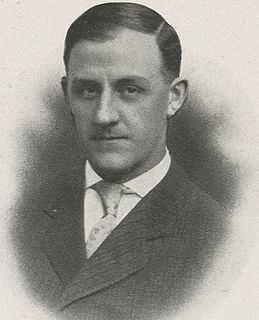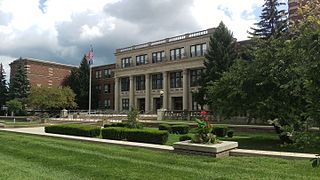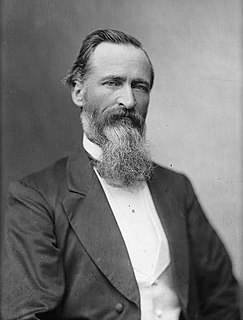
Caleb Mills (July 29, 1806–October 17, 1879) was an American educator who served as the Superintendent of Public Instruction in Indiana and was the first faculty member at Wabash College. He played a central role in designing the public education system of Indiana.
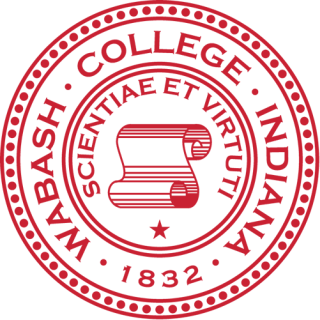
Wabash College is a private, men's, liberal arts college in Crawfordsville, Indiana with about 920 students. Founded in 1832 by several Dartmouth College graduates and Midwestern leaders, Wabash is ranked in the top tier of national liberal arts colleges.

Indiana is a U.S. state located in the Midwestern and Great Lakes regions of North America. Indiana is the 38th largest by area and the 17th most populous of the 50 United States. Its capital and largest city is Indianapolis. Indiana was admitted to the United States as the 19th U.S. state on December 11, 1816. Indiana borders Lake Michigan to the northwest, Michigan to the north, Ohio to the east, Kentucky to the south and southeast, and Illinois to the west.
Contents
Caleb Mills arrived in Crawfordsville, Indiana in November 1833 with his bride Sarah, after graduating from Dartmouth College in 1828 and Andover Theological Seminary in 1833, [1] to become the first professor and the principal of the Crawfordsville Classical High School, which opened in December 1833 with 12 students. As soon as a charter could be obtained from the state legislature it became the Wabash Teachers Seminary and Manual Labor College, finally acquiring the name Wabash College in 1851 (Osborne 1932, p. 31). Mills, fresh out of divinity school, was recruited to the job by his old college roommate Edmund Otis Hovey, one of the nine founders of the school, who later joined him on the faculty as one of the professors. In the early days it was Mills' task as the sole teacher to teach all the classes in every subject, and additionally to serve as the pastor of a church six miles outside of town on weekends. [2]
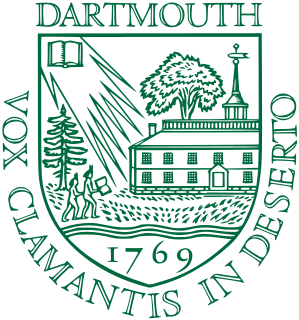
Dartmouth College is a private Ivy League research university in Hanover, New Hampshire, United States. Established in 1769 by Eleazar Wheelock, it is the ninth-oldest institution of higher education in the United States and one of the nine colonial colleges chartered before the American Revolution. Although founded as a school to educate Native Americans in Christian theology and the English way of life, Dartmouth primarily trained Congregationalist ministers throughout its early history. The university gradually secularized, and by the turn of the 20th century it had risen from relative obscurity into national prominence as one of the top centers of higher education.

Andover Theological Seminary is located in Newton, Massachusetts, and is the oldest graduate school of theology in the United States. Andover Theological Seminary and Newton Theological Institution merged formally in 1965 to form the Andover Newton Theological School.
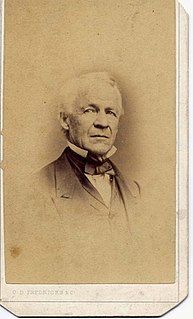
Edmund Otis Hovey, D.D. was an American Presbyterian minister and Wabash College founder. He was born in East Hanover, N.H., July 15, 1801. At twenty-one years of age he began his preparation for preaching the gospel, at Thetford Academy; in 1828 graduated from Dartmouth College, and in 1831 from Andover Theological Seminary. He was ordained by the Presbytery of Newburyport the same year, and sent as a missionary to Wabash, Iowa. His great work was in founding and building up Wabash College, Crawfordsville, Indiana, of which, in 1834, he was appointed financial agent and professor of rhetoric. Subsequently he was made professor of chemistry, mineralogy, and geology. He was also treasurer and librarian. He died there, March 10, 1877. See (N.Y.) Evangelist, March 29, 1877.
Starting in 1846, for six years, Mills wrote an annual address to the Indiana legislature on the subject of public education. In these letters, arguing for a statewide system of taxpayer funded free public schools, he made the case that the benefits of a "good and efficient system of free schools" would pay for themselves, and described the parts that would be needed for such a system, including township school committees, district superintendents, school libraries, and normal schools to train teachers. These addresses were printed in the Indiana State Journal under the byline "One of the People", and were the main influence on the new school law, embracing most of Mills' proposals, which was drafted and adopted by the state constitutional convention in 1852. [3]
In 1854 Caleb Mills was elected Indiana Superintendent of Public Instruction, defeating the incumbent Democrat, William C. Larrabee, 99,857 to 85,835. [4] Mills, a Whig, ran on a fusion ticket called the People's Party which brought together Whigs, Free Soilers, Know-Nothings and temperance advocates to support a common slate. Mills, after serving one term, did not stand for re-election in 1856 and Larrabee regained the office.
The Superintendent of Public Instruction is an elected office in the state government of Indiana. The official is an elected member of the executive branch of government and work with the state Board of Education as head of the Indiana Department of Education to oversee certain areas of public schools in Indiana. The position was created in 1851 with the adoption of the Constitution of Indiana, and filled in the first general election following its creation.
William C. Larrabee (1802–1859) was the third president of DePauw University.
Mills remained on the faculty of Wabash College, teaching Greek and serving as curator of the college library, until his death in 1879 (Osborne 1932, p. 144).
Indiana State University has recognized Mills' immeasurable contributions to education in Indiana by naming one of their residence halls for Mills. In addition, the highest university honor an Indiana State faculty member can receive is the Caleb Mills Teaching Award.

Indiana State University (ISU) is a public university in Terre Haute, Indiana. It was founded in 1865 and offers over 100 undergraduate majors and more than 75 graduate and professional programs. Indiana State is classified by the Carnegie Classification of Institutions of Higher Education as a Doctoral/Research University.

